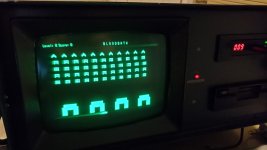ECNeilson
Member
I also have a Kaypro IV with some flaky SD-521s and I lucked out on the Internet Archive today and found an Epson PC service manual that includes full specs and maintenance steps for the SD-521: Epson Equity II Service Manual, Chapter 6.
You will still probably need an alignment disk for radial alignment, but it's nice to have the full set of maintenance instructions. Also, in a pinch, ImageDisk has a Disk Analysis mode that beeps based on the strength of the read signal. You adjust the radial alignment while listening to the beeps for maximum signal.
You will still probably need an alignment disk for radial alignment, but it's nice to have the full set of maintenance instructions. Also, in a pinch, ImageDisk has a Disk Analysis mode that beeps based on the strength of the read signal. You adjust the radial alignment while listening to the beeps for maximum signal.

